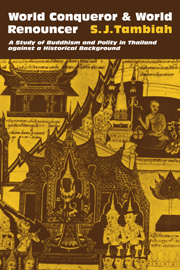 World Conqueror and World Renouncer
World Conqueror and World Renouncer Published online by Cambridge University Press: 10 November 2010
In this chapter I should like to deal with how some of the leading scholarmonks and laymen in Thailand have in the course of this century attempted to interpret the relevance of the Buddhist dhamma (doctrine) and of the sangha (order of monks) for contemporary society. There are two general aspects to these attempts at formulating a religion relevant to the times. There is a looking back to the pristine form of the religion and its canonical texts (as opposed to later accretions) in order to find the alleged pure and timeless truth. There is also the attempt to formulate answers to challenges and tasks that confront the modern man of religion by virtue of his living in a specific moment of history. Thus the search for the timeless truths and the situational truths involves interpretation, and the answers advanced by different advocates may therefore crystallize differently.
Social scientists primarily focusing on the modernization process have tried to put different labels on these different mixes: (1) Thus religious neotraditionalism is characterized as a stance “in which the modern components are maintained only as instruments for furthering nonmodern or antimodern values and ends,” “an ideology designed to keep change to a minimum and defend the status quo as far as possible.”
To save this book to your Kindle, first ensure [email protected] is added to your Approved Personal Document E-mail List under your Personal Document Settings on the Manage Your Content and Devices page of your Amazon account. Then enter the ‘name’ part of your Kindle email address below. Find out more about saving to your Kindle.
Note you can select to save to either the @free.kindle.com or @kindle.com variations. ‘@free.kindle.com’ emails are free but can only be saved to your device when it is connected to wi-fi. ‘@kindle.com’ emails can be delivered even when you are not connected to wi-fi, but note that service fees apply.
Find out more about the Kindle Personal Document Service.
To save content items to your account, please confirm that you agree to abide by our usage policies. If this is the first time you use this feature, you will be asked to authorise Cambridge Core to connect with your account. Find out more about saving content to Dropbox.
To save content items to your account, please confirm that you agree to abide by our usage policies. If this is the first time you use this feature, you will be asked to authorise Cambridge Core to connect with your account. Find out more about saving content to Google Drive.